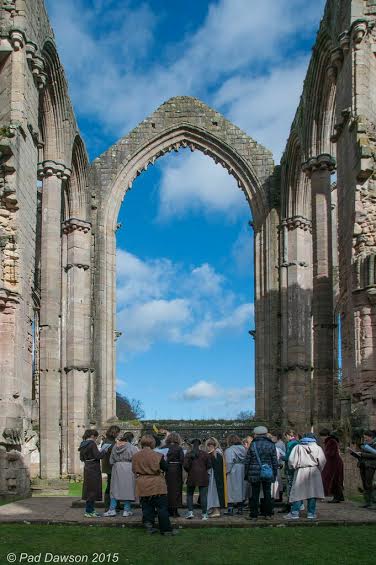
When teachers bring parties of children to Fountains Abbey, we often tog them all up in monastic robes, and explore the site with them .We want them to get a feel of the day-to-day life of a mediaeval monk. What? Prayers eight times a day? No underclothes? No talking? No heating? They’re impressed, in a horrified kind of way.
Then they go away, with only brief notions of the story the Abbey itself has to tell. Or why the place is a roofless ruin.
Until this year. Now they can come with their teachers and ‘Act the Facts’. They’re given props – perhaps a simple cape, a feathered cap, a woollen robe, a crown . These turn them into an early monk, a master mason, an Italian wool merchant, a dastardly baron, or even Henry VIII.
They have a script. It’s a melodramatic pastiche telling the Abbey’s turbulent history. Simple God-fearing beginnings, then powerful prosperity, then war, plague and corruption all leading to the final action. Henry VIII dissolves the monasteries.
The question at the beginning of the play is –
‘Who destroyed the Abbey?’
Acting it out, the children lose their places, stumble over words like ‘Cistercian’ and ‘lavatorium’, and forget which character they’re playing.
Honestly, what’s the point? It’s too complicated. They’re learning nothing.
Then they reach the end. We ask them to line themselves up. Twelfth century characters first, then thirteenth… and so on, through to those who bring the story to an end in 1540. We ask them which century was best.
And that’s when we realise how much they’ve learnt. They talk passionately about the simple piety of the early days set against the laxity of later centuries. They discuss austerity versus comfort. They talk feelingly about the plague, and the reasons for the Dissolution of the Monasteries.
And in telling the story of the Dissolution, they’ve solved the mystery of why Fountains Abbey is a roofless ruin.
Back at school, there’s so much for their teachers to build on. The ruin has brought history to life.
Come and see it for yourselves. We can’t promise you a feathered cap, or a cardboard crown, but you could join one of the regular tours. You’ll get a real taste of history as you soak up the special atmosphere of this special site.

Totally endorse this. Go to Fountains Abbey, it is the most wonderful place ever,if you avoid school parties! Just joking! Congratulations on enabling children to get so much from their visit and I bet the other visitors enjoy watching the children act.
LikeLike
I think Fountains Abbey is big enough to absorb us all – and this history mystery isn’t really a set piece, so not too many other visitors try to watch the fun.
LikeLike
That’s just a wonderful approach to getting school kids engaged! History is so full of the things we all seem to like–drama, big personalities, intrigue–and, yet, most schools make it sooooooo boring. I really impressed with this technique!
LikeLike
Of course it’s the good teachers who tend to bring their children in the first place, so I doubt if their lessons are ever dull. It’s great fun, if exhausting.
LikeLike
Drama is definitely a great way to actively engage children with history. As a teenager I hated history and then our very modern history teacher suggested we made a video about the French Revolution!! I still remember it today, I was one of the reporters interviewing some of the protagonists. The project even engaged the 14 year old class troublemaker when he got involved building the pretend guillotine. 😆
LikeLiked by 1 person
Brilliant! I can’t believe you hated history, though. You bring such an appreciation of the past to your work, and when you take us on virtual visits to, for instance, the mediaeval art of East Anglia.
LikeLike
How kind of you to say so. It’s been a long and convoluted route from my science degree!!
LikeLiked by 1 person
Science degree? Now I really am astonished. Wow. Multi-talented or what?
LikeLike
No, not really just took a long while to find out what I was really interested in. I think the pressure on the youngsters is even worse now. And, once you set off on one track in the education system it takes a lot of confidence to say no this is all wrong. Of course, there’s no way I could have gone back and done Art History nowadays with the £9000 per year fees. My daughter is about to finish her MSCi and will owe 4 years worth of fees plus living – such a daunting start to adult life.
LikeLiked by 1 person
it is amazing how it all clicks in their heads, in a way. Our group took a field trip in December and history came alive for my 13 and 14 year olds. We’ve got another trip coming in a month – the Holocaust Museum in conjunction with our learning about WWII and the Holocaust. They read Night by Holocaust survivor Elie Wiesel in their language Arts class and they learn history from me. It will be my first time on this trip, but I visited the National Holocaust Museum in Washington, DC several years ago and it was chilling. there is nothing like the experience, even if it scripted. They learn, indeed. Have a wonderful week.
LikeLiked by 1 person
Hello stranger! You’ve been quiet for a while! I wish you could bring your pupils to Fouuntains Abbey. I know it’s an opportunity you would seize with both hands. Hope life’s not TOO busy just now.
LikeLiked by 1 person
Thank you. Life has been a bit out of control lately – in all of my roles – slowly crawling back to life.
LikeLiked by 1 person
Hope all’s well. Good luck!
LikeLiked by 1 person
Thank you – 3 days from now – warm vacation, sand between my toes… Much needed for all of us
LikeLiked by 1 person
Oh how I envy those children.
LikeLike
They had fun. As did we.
LikeLiked by 1 person
Great story. You had me there for a moment and I thought it was not going to end well or as you said ‘what’s the point’. Then between their great teachers and guides and their own way of learning, they got it! And perhaps there’s a few more kids turned on to history through your efforts😊
LikeLike
Let’s hope so!
LikeLike
What an awesome experience for the students! They’ll never forget it. Educational experiences like this can really make history come alive.
LikeLiked by 1 person
I hope so. I’m just a beginner helping with this particular project, but I’ve seen the positive effects.
LikeLike